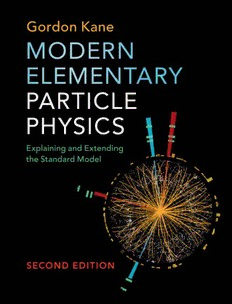Table Of ContentKane FM.tex 16/12/2016 11:27 Pageii
Kane FM.tex 16/12/2016 11:27 Pagei
ModernElementaryParticlePhysics
SecondEdition
ThistextwaswrittenforstudentsandscientistswantingtolearnabouttheStandard
Modelofparticlephysics.Onlyanintroductorycourseknowledgeaboutquantumthe-
oryisneeded.Itprovidesapedagogicaldescriptionofthetheory,andincorporatesthe
recentHiggsbosonandtopquarkdiscoveries.
With its clear and engaging style, this new edition retains its essential simplicity.
Long and detailed calculations are replaced by simple approximate ones. It includes
introductionstoaccelerators,colliders,anddetectors.Severalmainexperimentaltests
oftheStandardModelareexplained.Descriptionsofsomewell-motivatedextensions
oftheStandardModelpreparethereaderfornewdevelopments.
ThetextemphasizestheconceptsofgaugetheoriesandHiggsphysics,electroweak
unificationandsymmetrybreaking,andhowforcestrengthsvarywithenergyandthus
providesasolidfoundationforthoseworkinginthefieldandforthosewhosimplywant
tolearnabouttheStandardModel.
GordonKaneisVictorWeisskopfDistinguishedUniversityProfessorattheUniver-
sityofMichigan.From2005until2012hedirectedtheMichiganCenterforTheoretical
Physics (MCTP), a leading center for the advancement of theoretical physics. In
2012 he received the Lilienfeld Prize from the American Physical Society. He is an
internationally recognized scientific leader in theoretical and phenomenological par-
ticle physics, Higgs physics, supersymmetry, cosmology, dark matter, and theories
for physics beyond the Standard Model. In recent years he has been a leader in
stringphenomenology.HeisafellowoftheAmericanPhysicalSociety,theAmerican
AssociationfortheAdvancementofScience,andtheBritishInstituteofPhysics.
Kane FM.tex 16/12/2016 11:27 Pageii
Kane FM.tex 16/12/2016 11:27 Pageiii
Modern Elementary Particle
Physics
Second Edition
GORDONKANE
UniversityofMichigan,AnnArbor
Kane FM.tex 16/12/2016 11:27 Pageiv
UniversityPrintingHouse,CambridgeCB28BS,UnitedKingdom
OneLibertyPlaza,20thFloor,NewYork,NY10006,USA
477WilliamstownRoad,PortMelbourne,VIC3207,Australia
4843/24,2ndFloor,AnsariRoad,Daryaganj,Delhi–110002,India
79AnsonRoad,#06-04/06,Singapore079906
CambridgeUniversityPressispartoftheUniversityofCambridge.
ItfurtherstheUniversity’smissionbydisseminatingknowledgeinthepursuitof
education,learning,andresearchatthehighestinternationallevelsofexcellence.
www.cambridge.org
Informationonthistitle:www.cambridge.org/9781107165083
10.1017/9781316691434
©WestviewPress1993
©GordonKane2017
Thispublicationisincopyright.Subjecttostatutoryexception
andtotheprovisionsofrelevantcollectivelicensingagreements,
noreproductionofanypartmaytakeplacewithoutthewritten
permissionofCambridgeUniversityPress.
FirstEditionin1993byWestviewPress
SecondEdition2017
PrintedintheUnitedKingdomby
TJInternationalLtd.PadstowCornwall
AcatalogusrecordforthispublicationisavailablefromtheBritishLibrary.
LibraryofCongressCataloging-in-PublicationData
ISBN978-1-107-16508-3Hardback
Cambridge University Press has no responsibility for the persistence or accuracy of
URLsforexternalorthird-partyInternetwebsitesreferredtointhispublicationand
does not guarantee that any content on such websites is, or will remain, accurate or
appropriate.
Kane FM.tex 16/12/2016 11:27 Pagev
Contents
Preface pagex
1 Introduction 1
1.1 TheFrameworkandtheRules 2
1.2 TheForces 4
1.3 TheParticles 5
1.4 NaturalUnits 9
2 RelativisticNotation,Lagrangians,andInteractions 10
2.1 SomeRelativisticNotation 10
2.2 Lagrangians 11
2.3 LagrangiansinParticlePhysics 13
2.4 TheRealScalarField 13
2.5 SourcesandCurrentsinNon-RelativisticQuantumTheory 14
2.6 ComplexScalars,ConservedCurrents,andNoether’sTheorem 15
2.7 Interactions 18
2.8 SummaryoftheLagrangians 20
2.9 FeynmanRules 22
3 GaugeInvariance 24
3.1 GaugeInvarianceinClassicalElectromagnetism 24
3.2 GaugeInvarianceinQuantumTheory 25
3.3 CovariantDerivatives 27
4 Non-AbelianGaugeTheories 29
4.1 StrongIsospin,anInternalSpace 29
4.2 Non-AbelianGaugeTheories 32
4.3 Non-AbelianGaugeTheoriesforQuarksandLeptons 33
5 DiracNotationforSpin 36
5.1 TheDiracEquation 36
5.2 MasslessFermions 37
5.3 FermionswithNon-ZeroMass 37
5.4 TheGammaMatrices 38
5.5 Currents 39
5.6 FreeParticleSolutions 40
v
Kane FM.tex 16/12/2016 11:27 Pagevi
vi Contents
5.7 ParticlesandAntiparticles 42
5.8 Left-HandedandRight-HandedFermions 42
5.9 UsefulRelations 43
5.10 TheDiracLagrangian 44
6 TheStandardModelLagrangian 46
6.1 LabelingtheQuarkandLeptonStates 47
6.2 TheQuarkandLeptonLagrangian 50
6.3 GaugingtheGlobalSymmetries 51
7 TheElectroweakTheoryandQuantumChromodynamics 53
7.1 TheU(1)Terms 53
7.2 TheSU(2)Terms 53
7.3 ConnectiontoExperimentalFacts:NeutralCurrent 54
7.4 ConnectiontoExperimentalFacts:ChargedCurrent 58
7.5 TheQuarkTerms 60
7.6 TheQuarkQCDLagrangian 60
7.7 TheSecondandThirdFamilies 61
7.8 TheFermionGaugeBosonLagrangian 62
7.9 Masses? 63
8 MassesandtheHiggsMechanism 64
8.1 SpontaneousSymmetryBreaking 64
8.2 ComplexScalarField–AGlobalSymmetry 67
8.3 TheAbelianHiggsMechanism 68
8.4 TheHiggsMechanismintheStandardModel 71
8.5 FermionMasses 74
8.6 CommentonVacuumEnergy 76
9 CrossSections,DecayWidths,andLifetimes;WandZDecays 77
9.1 RelationofLifetimeandResonanceWidthtoDecayProbability 79
9.2 ScatteringThroughaResonance 79
9.3 TheW Width 82
9.4 TheZ0Width 84
9.5 BranchingRatios 87
10 ProductionandPropertiesofW(cid:6)andZ0 88
10.1 GettingQuarkstoCollide 89
10.2 TheConstituentCrossSection 90
10.3 TheW ProductionCrossSection 90
10.4 TheW DecayandTotalEventRate 92
10.5 MeasurementofZ0andW(cid:6)MassesatHadronColliders 93
10.6 TheW SpinandDecayAsymmetry 95
Kane FM.tex 16/12/2016 11:27 Pagevii
vii Contents
11 MeasurementofElectroweakandQCDParameters;theMuonLifetime 97
11.1 MeasurementandSignificanceofsin2(cid:18) 97
w
11.2 MuonDecay 98
11.3 Measurementof(cid:11) 102
3
11.4 CommentsonStandardModelParameters 104
12 Accelerators--PresentandFuture 106
12.1 ParametersofAccelerators 106
12.2 UsefulEnergy 108
12.3 PresentandApprovedFacilities 109
13 ExperimentsandDetectors 111
13.1 WhatEmergesfromaCollider 111
13.2 Triggering 113
13.3 ElementsofLargeDetectors 114
13.4 MajorDetectors 115
14 LowEnergyandNon-AcceleratorExperiments 117
15 ObservationoftheHiggsBosonattheCERNLHC;isittheHiggsBoson? 119
15.1 DiscoveringandStudyingHiggsBosonsatLHC 120
15.2 HiggsDecays 121
15.3 Higgs Vacuum Expectation Value and Electroweak Symmetry
Breaking 124
15.4 InterpretingtheObservedHiggsBoson–EvidenceforSupersymmetry? 124
16 CollidersandTestsoftheStandardModel;ParticlesarePoint-Like 126
16.1 AreQuarks,Leptons,Gluons,andGaugeBosonsPoint-Like? 127
16.2 TheTauLepton 129
16.3 ObservationofGluons 130
17 QuarksandGluons,ConfinementandJets 132
17.1 ConfinementofColor,andColor-SingletHadrons 132
17.2 Color-SingletHadrons 135
17.3 QuantumNumbersofMesonsandBaryons 136
17.4 CommentsandPerspective 138
18 Hadrons,HeavyQuarks,andStrongIsospinInvariance 139
18.1 TheL=0MesonStates 139
18.2 TheL=0BaryonStates 140
18.3 DecaysandTransitions 141
18.4 TheSurprisingOriginofStrongIsospinInvariance 142
18.5 HeavyQuarks(c,b,t) 143
18.6 SomePropertiesofCharmonium 144
Kane FM.tex 16/12/2016 11:27 Pageviii
viii Contents
18.7 CharmedMesonsandtheCharmoniumSpectrum 146
18.8 MoreLeptonsandQuarks 149
18.9 ThebQuark 149
18.10TheTopQuark 150
19 CouplingStrengthsDependonMomentumTransferandonVirtualParticles 152
19.1 QuantumElectrodynamics 153
19.2 QuantumChromodynamics 158
19.3 Corrections to Precision Measurements from Intermediate States
withHeavyParticles 160
20 Quark(andLepton)MixingAngles 162
21 CPViolation 167
22 OverviewofPhysicsBeyondtheStandardModel 170
23 GrandUnification 172
23.1 Unifying Quarks and Leptons; Electric Charge and the Number
ofColors 172
23.2 UnificationofForces 173
23.3 Calculationofsin2(cid:18) 176
w
23.4 ProtonDecay 179
24 NeutrinoMasses 183
24.1 Ifm ̸=0;NeutrinoOscillations 184
(cid:23)
24.2 SolarNeutrinos 186
24.3 AtmosphericNeutrinos 188
24.4 SummaryofData 188
24.5 ExpectationsforNeutrinoMasses 189
25 DarkMatter 191
25.1 ObservingDarkMatterinLaboratoryDetectors 192
25.2 ObservingDarkMatterinSatelliteDetectors 193
25.3 SubtlePoints 194
26 Supersymmetry 195
26.1 WhyisSupersymmetrysuchanAttractiveApproach? 196
26.2 SupersymmetryFeynmanRulesandCalculations 197
26.3 ProductionandDetectionofSupersymmetricPartners 198
AppendixA AngularMomentumandSpinandSU(2) 202
AppendixB SomeGroupTheory 207

